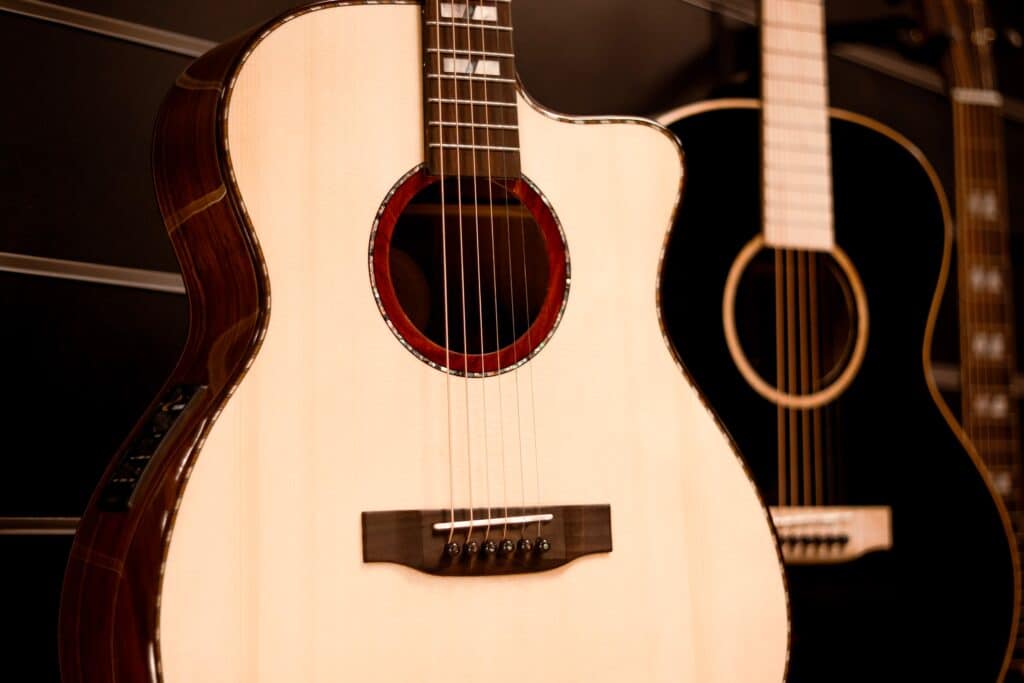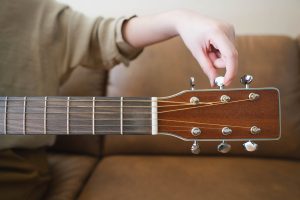
Are you a beginner guitarist? Have you been wondering what size guitar you should get? This is the ultimate guide to finding the perfect sized guitar for you.
Smaller guitar sizes are best for people with smaller hands, while larger models are better for those with bigger fingers. Larger guitars typically have a fuller sound suitable for classical or folk genres, while smaller options provide more control over tones and notes.
We have explored further guidelines such as your overall body size, variety of guitar sizes, various age groups, and playability and their role in finding the right-sized guitar.
Variety of Guitar Sizes
The guitar sizes can vary significantly in length and width, and they typically range between 20 inches and 44 inches long. 1/4 scale of a guitar measures around 19 inches. While the full size 4/4 scale guitar measures around 41-44 inches.
The most common guitar size is the folk guitar, which is typically 32 inches long and has a 15 inches wide body. Other guitar sizes include dreadnought, parlor guitar, and concert guitar.
Each guitar size has distinctive qualities that make it ideal for certain playing styles or genres.
For example, the dreadnought guitar is usually used for playing country music due to its large soundbox and resonant voice. In contrast, fingerstyle players prefer the parlor guitar due to its smaller size and delicate tone.
Whether you are looking for a loud electric guitar or a warm acoustic model, choosing the right guitar size can make all the difference.
Choosing Guitar Size By Height

When choosing a guitar size, several factors need to be considered. First and foremost, it’s essential to consider your height, as this will directly affect which size guitar is best for you.
Generally speaking, smaller-framed individuals will tend to do best with a ¾ or full-size guitar, while taller individuals should always play with full-size guitars. See the table below to see which size is suitable for which heights.
| Guitar Size | Person’s height (in) | Person’s height (cm) |
| ¼ | 42.5″ – 49.2″ | 107-125cm |
| ½ | 50.4″ – 58.7″ | 128-149cm |
| ¾ | 59.0″ – 62.0″ | 150-155cm |
| Full-size guitar | 61.0″ and above | 156cm and above |
Another thing to keep in mind is the type of music you plan on playing when choosing your guitar size.
A heavier gauge string is better suited for rock and metal players who play at higher volumes, while lighter gauge strings are better suited to jazz and folk musicians who prefer a softer touch.
Choosing Guitar Size By Age
When it comes to guitar playing, age is just a number. You’re never too old or too young to start learning. However, the size of the guitar can make a big difference in how easy or difficult it is to play.
Here’s a breakdown of the different guitar sizes and what age group they’re best suited for.
Small-Sized Guitars
Small guitars, such as ¼, ½, and ¾ size, are great for younger kids aged four to twelve. They’re lightweight and easy to hold, and they have shorter fretboards, making them easier to play.
Medium-Sized Guitars
Medium-sized guitars, such as full-size and dreadnought guitars, are ideal for kids aged 12 and above and adults of average heights. They’re still relatively lightweight, but they have longer fretboards that can be a bit challenging for smaller hands.
Large-Sized Guitars
Large guitars, such as jumbo guitars, are best for adults with large hands or long fingers. These guitars can be hard to hold if you’re not used to them, but they have a rich sound, which is perfect for strumming and fingerpicking.
Guitar Size vs. Playability
When it comes to playing guitar, the size of the instrument plays a huge role. Different size guitars will have different playability tones, depending on the size and shape of the guitar body and its thickness and weight.
For example, a guitar with a large body may be better suited for big, booming chords and deep notes, while a guitar with a slimmer body might be more suited for intricate melodies and quicker transitions.
Smaller guitars are also easier to hold and maneuver, especially for beginner guitar players who may need help getting used to the instrument.
Ultimately, choosing the right guitar size is often a matter of personal preference. Some guitar players may prefer larger guitars with rich overtones, while others prefer a smaller guitar that allows them to explore more subtle tonal variations.
But regardless of what size or type you choose, when you feel comfortable holding your instrument, then with practice and dedication, you can play any size guitar like a pro in no time!
Conclusion
What guitar size should you get? It depends on your age, height, and personal preferences. If you’re just starting out, it might be good to go with a smaller guitar that is easier to handle. If you have some experience, you may want to try a larger one that will give you a fuller sound. But ultimately, it’s up to you to decide which size is right for you and which feels comfortable to hold in your hands.
Frequently Asked Questions
The best guitar size for beginners is a medium-sized guitar (3/4). These guitars are lightweight and have shorter fretboards, making them easier to play.
The best guitar size for adults is a full-sized guitar (4/4). If you are very tall, consider a 41” Dreadnought size guitar.
The best guitar size for metal is a large-sized guitar. These guitars have a rich sound that’s perfect for strumming and fingerpicking.








